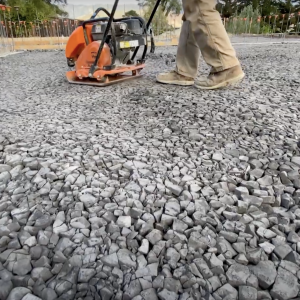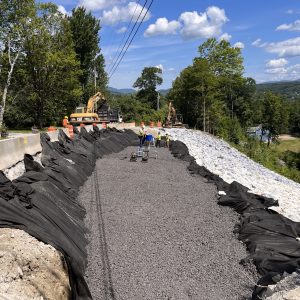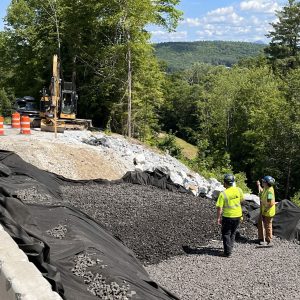Lightweight Fill Introduction
Foam glass gravel is used as lightweight insulating fill in cases of soft soil support, embankments, mechanically stabilized earth walls, retaining structures, and subgrade for roadways. Lightweight aggregate fill is used to reduce load on soft soil areas by replacing soil or other heavy aggregates to alleviate settlement and strain on surrounding areas.
Foam glass gravel’s material properties uniquely position the material to solve pervasive issues in construction. Weighing only 10 pounds per cubic foot, Glavel has 116psi compressive strength and a closed cell structure that provides R1.7 insulation per inch while minimizing water absorption. Foam glass gravel is made from 100% post consumer recycled glass. This gives it a unique sustainability footprint when compared to other lightweight aggregate fills, such as Geofoam, expanded shale, Perlite, and cellular concrete. In many cases, it’s also less expensive than alternative fills.
Foam Glass Manufacturing + Installation
Manufacturing foam glass gravel begins with post-consumer recycled glass. It’s cleaned to remove 99% of non-glass and impurities, then ground into a fine powder. The powder is mixed with a foaming agent and run through a kiln, at which point the glass powder reacts with the foaming agents and expands to 4x it’s original thickness. Upon exiting the kiln, thermal stress from hitting ambient temperature air causes the foam glass slab to break into aggregate pieces.
To install Glavel, a woven geotextile fabric is laid down in the installation area. This prevents fines and other granular materials from mixing in with the Glavel over time and serves as a separation layer from soil or other subgrade materials. Glavel is deposited into the space it’s filling, grated to a tolerated flatness, then compacted. Unlike traditional aggregates, Glavel is compacted at a 1.3 :1 ratio. Additional compaction will not increase compressive strength or insulative values, though the installed weight will increase. Plate compactors are successful in compacting Glavel to the specified 1.3 : 1 compaction. Glavel pieces fracture during compaction, which fills interstitial spaces and interlocks pieces. Glavel pieces are abrasive and frictional, so compaction locks them into place, a contributing factor to the high compressive strength. Compaction is done in lifts of up to a maximum of 12” to allow for even interlocking and compaction. Even when fully compacted, Glavel is free-draining and allows moisture to percolate through. See Glavel installed in West Rutland, Vermont as lightweight fill underneath a roadbed here.



Glavel’s particle size ranges from 1.25” to 2.5”. As a closed cell material, each individual aggregate piece holds air, which makes the product both lightweight and insulative. This also contributes to upward forces due to buoyancy. When used in areas below the water table or in areas that regularly have flooding, proper caution should be taken to ensure that significant ballast is placed on the Glavel layer. This will prevent shifting and when Glavel is exposed to these conditions.
Foam glass gravel provides unique solutions to many issues faced by industry professionals. Engineers, architects, designers, and contractors alike can benefit from the many product attributes that make foam glass gravel stand alone compared other lightweight insulating fills.
